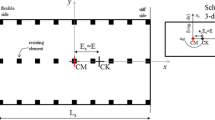Abstract
The paper investigates the influence of design procedures on the seismic response of multi-storey asymmetric buildings. To this end, some structures are designed according to methods based on either static or modal analysis, with or without design eccentricities. The seismic response of these systems is determined by means of inelastic dynamic analyses and the design is thoroughly examined in order to explain the results of the dynamic analyses. Attention is basically focused on the ability of design methods to prevent asymmetric buildings from experiencing ductility demands much larger than those of the corresponding torsionally balanced systems. Numerical analyses underline that while design procedures based on either static or modal analysis are suitable for the design of torsionally rigid structures only those based on modal analysis lead to the satisfactory performance of torsionally flexible buildings. Furthermore, the study highlights the qualities of a design method proposed by the Authors. Its application does not require any explicit calculation of design eccentricities and leads to proper seismic response of both torsionally rigid and flexible asymmetric buildings.
Similar content being viewed by others
References
Anastassiadis K, Athanatopoulos A and Makarios T (1998). Equivalent static eccentricities in the simplified methods of seismic analysis of buildings. Earthq Spectra 14: 1–34
Calderoni B, D’Aveni A, Ghersi A and Rinaldi Z (2002). Static versus modal analysis of asymmetric buildings: effectiveness of static eccentricity formulations. Earthq Spectra 18(2): 219–231
Chandler AM and Duan XN (1992). A modified static procedure for the design of torsionally unbalanced multistorey frame buildings. Earthq Eng Struct Dynam 22: 447–462
De Stefano M, Marino EM and Rossi PP (2006). Effect of overstrength on the seismic behaviour of multi-storey regularly asymmetric buildings. Bull Earthq Eng 4(1): 23–42
Der Kiureghian A (1981). A response spectrum method for random vibration analysis of MDF systems. Earthq Eng Struct Dynam 9: 419–435
Duan XN and Chandler AM (1992). Inelastic seismic response of code-designed multistorey frame buildings with regular asymmetry. Earthq Eng Struct Dynam 22: 431–445
Eurocode 8 (1993) Design provisions for earthquake resistance of structures. European Committee for Standardisation ENV 1998–1-1/2/3
Fajfar P, Marusic D and Perus I (2005). Torsional effect in the pushover-based seismic analysis of buildings. J Earthq Eng 9(6): 831–854
Ghersi A, Marino E and Rossi PP (1999). Influence of design criteria on the inelastic response of regularly asymmetric multi-storey buildings. European Workshop on the Seismic Behaviour of Asymmetric and Set-back Structures, Istanbul, Turkey
Ghersi A and Rossi PP (2000). Formulation of design eccentricity to reduce ductility demand in asymmetric buildings. Eng Struct 22(7): 857–871
Ghersi A and Rossi PP (2001). Influence of bi-directional ground motions on the inelastic response of one-storey in-plan irregular systems. Eng Struct 23(6): 579–591
Ghersi A and Rossi PP (2006). Influence of design procedures on the seismic response of bi-eccentric plan-asymmetric systems. Struct Design Tall Spec Buil 15(4): 467–480
Goel RK, Chopra AK (1990) Inelastic seismic response of one-story, asymmetric-plan systems. Report no. UCB/EERC-90/14, Earthquake Engineering Research Center, Berkeley, California
Hejal R, Chopra AK (1987) Earthquake response of torsionally-coupled buildings. Report UCB/EERC-87/20, Earthquake Engineering Research Center, University of California, Berkeley, California
ICBO, International Conference of Building Officials (1997) Uniform Building Code. Whittier, California
Makarios T and Anastassiadis K (1998a). Real and fictitious elastic axes of multi-storey buildings: theory. Struct Design Tall Buil 7(1): 33–55
Makarios T and Anastassiadis K (1998b). Real and fictitious elastic axes of multi-storey buildings: applications. Struct Design Tall Buil 7(1): 57–71
Marino EM (2000) Comportamento sismico e criteri di progettazione di edifici multipiano irregolari in pianta. Ph.D. Dissertation, Faculty of Engineering, University of Catania, Italy. (in Italian)
Marino EM and Rossi PP (2004). Exact evaluation of the location of the optimum torsion axis. Struct Design Tall Spec Buil 13(4): 277–290
Marusic D and Fajfar P (2005). On the inelastic seismic response of asymmetric buildings under bi-axial excitation. Earthq Eng Struct Dynam 34: 943–963
Moghadam AS, Tso WK (1996) Seismic response of regular asymmetrical RC ductile frame buildings. European Workshop on the Seismic Behaviour of Asymmetric and Set-back Structures, Capri (Italy)
Moghadam AS and Tso WK (2000). Extension of Eurocode 8 torsional provisions to multi-storey buildings. J Earthq Eng 4: 25–41
Prakash V, Powell GH, Filippou FC (1992) DRAIN-BUILDING: program description and Users Guide. Report No. UCB/SEMM-92/31, University of California at Berkeley, Berkeley, California, USA
Rutenberg A (2002) Behaviour or irregular and complex structures asymmetric structures – progress since 1998. Proceedings of the 12th European Conference on Earthquake Engineering, London Elsevier, Oxford, Paper no. 832
Rutenberg A, Chandler AM, Duan XN and Correnza JC (1995). Non linear seismic response of asymmetric structures: bibliography. National Building Research Institute, Haifa
Stathopoulos KG and Anagnostopoulos SA (2003). Inelastic earthquake response of single-story asymmetric buildings: an assessment of simplified shear-beam models. Earthq Eng Struct Dynam 32: 1813–1831
Stathopoulos KG and Anagnostopoulos SA (2005). Inelastic torsion of multistorey buildings under earthquake excitations. Earthq Eng Struct Dynam 34: 1449–1465
Tso WK and Zhu TJ (1992). Design of torsionally unbalanced structural systems based on code provisions I: ductility demand. Earthq Eng Struct Dynam 21: 609–627
Zhu TJ and Tso WK (1992). Design of torsionally unbalanced structural systems based on code provisions II: strength distribution. Earthq Eng Struct Dynam 21: 629–644
Author information
Authors and Affiliations
Corresponding author
Rights and permissions
About this article
Cite this article
Ghersi, A., Marino, E.M. & Rossi, P.P. Static versus modal analysis: influence on inelastic response of multi-storey asymmetric buildings. Bull Earthquake Eng 5, 511–532 (2007). https://doi.org/10.1007/s10518-007-9046-1
Received:
Accepted:
Published:
Issue Date:
DOI: https://doi.org/10.1007/s10518-007-9046-1




